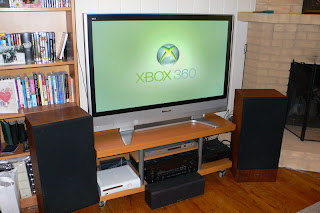
After the past few years dreaming about a plasma screen, we finally decided to get one.
I did some research, reading both magazine and user reviews, I found the Panasonic models to get consistently good ratings. I'm pretty familiar with their industrial models since I work in the Digital Signage industry, so that also gave me a good feeling about spending a considerable amount of money on a big screen.
I picked the TH-50PX60U. I also considered the 42 inch model, but Fran said "just go with the 50" so how could I argue? :)
There's also a newer model, the 600 series. It has better audio, a cable card slot and VGA input. But I didn't think that was worth $500 more.
Buying a competitive product like a plasma, digital camera or PC requires good timing and persistence. Prices for this screen varied wildly from below $2000 to over $3000. When I saw a sale at Best Buy for $1999, we jumped on it. This turned out to be a good deal, as it's now going for around $2500.
As an aside, it's interesting to see who really makes plasmas. Not all companies make the products they put their name on. Some buy from others, some make their own. Here a useful article about this.
Another big consideration is Plasma vs LCD. On one hand, LCD the newer of the two technologies. It has higher res, usually has VGA and DVI inputs and is much brighter.
But all that extra detail is not really noticeable from a distance (ie: your sofa). And because LCDs are based on a back-light to illuminate the screen, they can look washed out in dark scenes.
Plasmas have richer color, but are not as bright. If you dim the lights, they're fine. Burn-in is not as much an issue anymore- new models have better engineering and anti-burn-in features. But most of the basic models lack VGA input. Fortunately ours has HDMI and you can use a DVI to HDMI cable with your PC.
All things considered, it really comes down to personal taste. Go to a store and look at the same video on both types of screens and decide for yourself. Make sure you see both HD as well as standard video to see how it treats detail and up-scaling.
Here's a good review with suggestions for the best settings. Apparently the default settings are are over-saturated which makes for a nice demo in the show room, but not easy on the eyes when watching movies at home. A little adjustment and you're good to go. BTW, you have to make the same adjustments for EVERY input. They each keep separate memory of visual settings.

The TH-50PX60U has plenty of connectors. 2 sets of Component, 2 HDMI, S-Video, Composite. The speakers are not very powerful, but do a pretty good job at surround sound simulation.

The built-in tuner handles SD and ATSC signals. I picked up an amplified HD antenna at Best Buy and can get the major local networks (CBS, NBC, ABC, FOX) and a few other stations in HD. The HD versions of hit shows like Lost are just awesome to look at. It's even more amazing that these broadcast signals are free!

The remote is pretty basic, and works as a universal remote for VCRs, DVDs, etc.
No comments:
Post a Comment